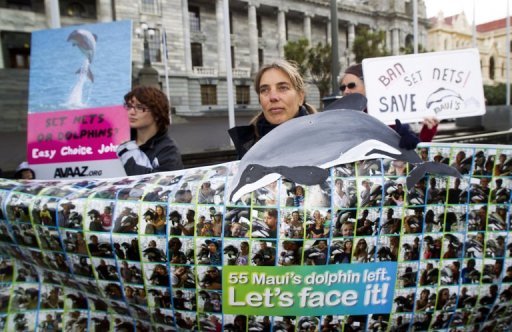New Zealand is facing pressure to save the world’s rarest dolphin at an international scientific meeting underway this week in what conservationists say is a test of the nation’s “clean, green” credentials.
The Maui’s dolphin, found only in shallow waters off the North Island’s west coast, is listed as critically endangered, with just 55 adults remaining and experts fearing it will disappear by 2030 unless urgent action is taken.
The grey and white Maui’s, named after a Polynesian demigod, is one of the world’s smallest dolphins, with a maximum length of 1.7 meters (5.5 foot).
Associate professor of zoology at Otago University Liz Slooten said an expert panel appointed by the government estimated last year that five of the dolphins were killed annually as fishing industry “bycatch.”
The New Zealand government believes that entanglement in gill nets–vertical mesh nets left in the water for long periods–is the main cause of death.
Conservation groups say proposals for seabed mining, including seismic surveying, also pose a major threat.
Some restrictions on gill netting and trawling in the dolphins’ habitat were introduced last year but the government stopped short of meeting an International Whaling Commission (IWC) call for an immediate ban to save the species.
Instead, it called for submissions to a threat management plan, saying it would assess both the risks facing the dolphins and “the potential impact of this extended ban on the local fishing community.”
While submissions for the management plan closed last November, no further action has been taken and critics accuse the government of stalling.
The issue was due to resurface at a meeting of the IWC scientific committee which opened in South Korea’s southern island of Jeju on June 3 and runs until June 15, where delegates were again set to urge Wellington to act.
The local fishing industry disputes allegations it is to blame for the dolphins’ demise, saying it has become a convenient scapegoat for environmentalists.
Keith Mawson, who runs a Taranaki fish processing firm, said there had only been one confirmed bycatch fatality in the past 25 years and that it may have been a Hector’s dolphin, rather than the closely related Maui’s.
He said the industry faced annihilation due to research conducted with the sole purpose of limiting fishing, while ignoring other potential causes of death, such as the parasitic disease toxoplasmosis.
Organizations such as the Society for Marine Mammalogy say evidence about the Maui’s plight is “extremely strong” and New Zealand, which has long marketed itself as “100 percent pure,” must act quickly if it wants to save the species.
Phil McCabe, a tourism operator who has established the environment group Kiwis Against Seabed Mining, said New Zealand’s international reputation as an environmental leader was on the line.
Slooten said the lack of action also opened up New Zealand to accusations of hypocrisy as it continued to strongly oppose Japanese whaling at forums like the IWC.

COMMENTS
Please let us know if you're having issues with commenting.